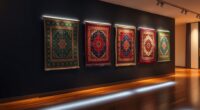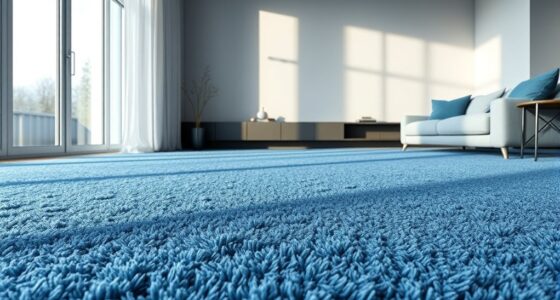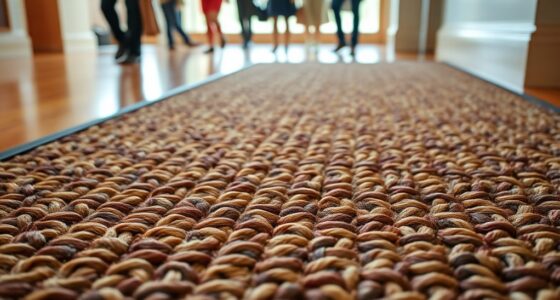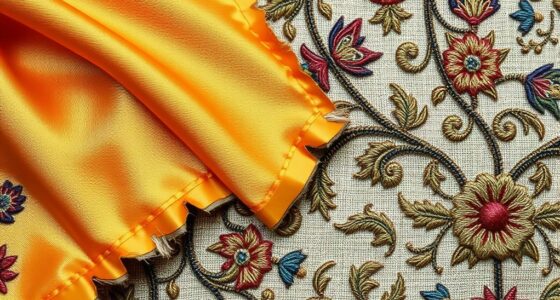If you’re interested in iconic French Savonnerie carpets, you’ll discover they are masterpieces of craftsmanship, rich in history and cultural symbolism. Known for intricate motifs, vibrant dyes, and regal designs, these carpets reflect centuries of artistry and tradition. Recognizing genuine pieces involves understanding their unique patterns and craftsmanship. As styles evolved, famous collections and factors like rarity influence their value. Exploring further reveals how to appreciate, collect, and preserve these extraordinary textiles for generations to come.
Key Takeaways
- Originated in 17th-century French royal workshops, symbolizing luxury, cultural heritage, and artistic craftsmanship.
- Recognized for intricate symmetrical patterns, vibrant natural dyes, and symbolic motifs reflecting history and mythology.
- Crafted using traditional weaving and dyeing techniques, ensuring durability, authenticity, and rich color palettes.
- Preservation relies on passing down techniques, verifying provenance, and maintaining condition and rarity.
- Featured in major museums and private collections, with evolving styles reflecting historical and modern artistic influences.
The Historical Roots of French Savonnerie Carpets

French Savonnerie carpets trace their origins back to the early 17th century when royal workshops began producing luxurious textiles for the French court. During this time, artisans incorporated symbolic motifs that reflected royal power, religious beliefs, and nature’s beauty. These motifs often held specific meanings, making each carpet a visual story. Over time, regional variations emerged, influenced by local cultures, materials, and craftsmanship styles. For instance, carpets from the Parisian workshops differ from those produced in other regions, showcasing unique artistic traditions. As you explore these carpets, you’ll notice how regional influences shape their design, while symbolic motifs connect each piece to France’s rich history and cultural identity. This blend of symbolism and regional diversity makes Savonnerie carpets truly fascinating. Additionally, the artistic techniques employed in creating these carpets highlight the mastery and innovation of French artisans across different periods. The weaving methods used also reflect the evolution of craftsmanship techniques, adding to the uniqueness of each piece. A deeper understanding of craftsmanship evolution reveals how technological advances and artistic trends influenced the intricate designs seen in these historic textiles. Furthermore, studying color application in these carpets provides insight into the dyeing processes and aesthetic preferences of different eras. Moreover, the use of regional influences often resulted in distinctive stylistic features that are still appreciated by collectors today.
Key Characteristics and Design Elements

The key characteristics of Savonnerie carpets are their intricate designs, rich color palettes, and distinctive craftsmanship. You’ll notice how textile dyeing techniques create vibrant, lasting hues that highlight detailed patterns. These carpets often feature symbolic motifs, reflecting courtly or religious meanings through carpet symbolism. To understand their design elements:
- Symmetrical floral and foliate patterns, emphasizing harmony and balance.
- Use of natural dyes for deep reds, blues, and golds, achieved through traditional textile dyeing.
- Central medallions surrounded by elaborate borders, drawing the eye inward.
- Incorporation of allegorical symbols representing power, spirituality, or nature. Color palette diversity showcases the skillful blending of hues, highlighting the artistry involved in their creation. Additionally, the traditional craftsmanship techniques passed down through generations ensure each piece maintains its authenticity and cultural significance. Preserving these techniques is essential for maintaining the cultural heritage of Savonnerie carpets, which enriches their historical value. A trusted custodian ensures the preservation and authenticity of these historic pieces, safeguarding their cultural significance for future generations. Recognizing the authenticity verification processes helps collectors appreciate the true value and origin of these exquisite carpets.
These elements showcase a blend of artistry and cultural storytelling, making each Savonnerie carpet a visual narrative rich in history.
The Craftsmanship Behind Each Rug
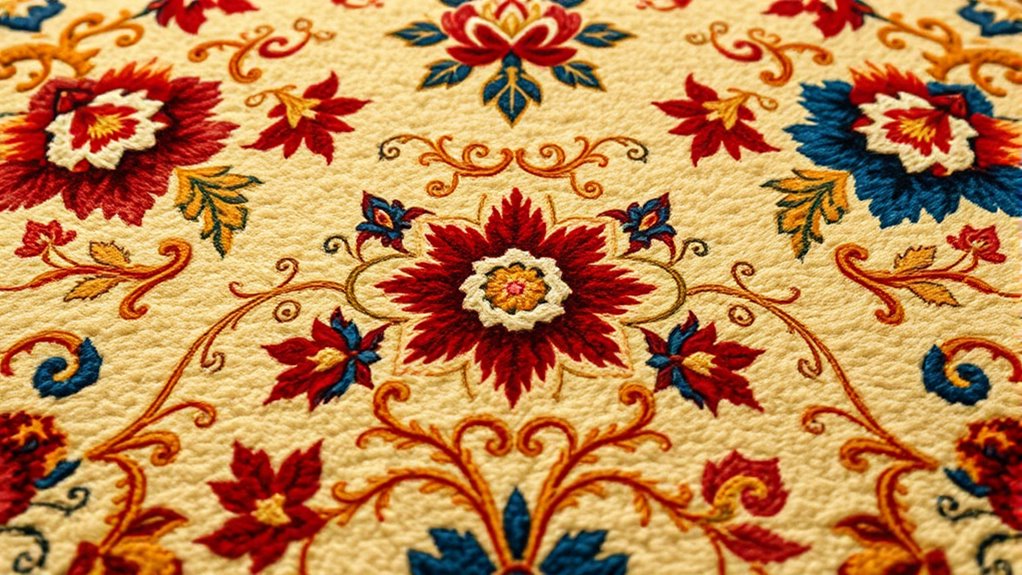
You can see the skill in every Savonnerie rug through traditional weaving techniques that require years of practice. The vibrant color palette is carefully applied, enhancing each piece’s intricate design. Artistic elements are thoughtfully integrated, making each rug a unique masterpiece of craftsmanship.
Traditional Weaving Techniques
Traditional weaving techniques form the heart of Savonnerie carpets, showcasing centuries of craftsmanship passed down through generations. Your process begins with intricate dyeing techniques, where natural dyes create rich, lasting colors. Next, you select weaving patterns that balance symmetry and detailed motifs, reflecting artistic traditions. As you weave, you utilize fine hand-knotting or tufting methods, ensuring durability and precision. You also pay close attention to the loom setup, maintaining tension for even pile height. Additionally, understanding economic factors can influence the choice of materials and techniques used in production. Incorporating modern tools like filtration and pump protection can help maintain consistent quality during manufacturing. You may also employ remote collaboration techniques to work with artisans across different regions, ensuring the transmission of traditional skills. Finally, finishing touches involve trimming and inspecting each rug for consistency. These techniques combine to produce the iconic look of French Savonnerie carpets, emphasizing craftsmanship and artistry. Every step, from dyeing to weaving patterns, reflects a deep respect for tradition and continuous mastery.
Vibrant Color Palette Use
Vibrant colors define the unique charm of Savonnerie carpets, and skilled artisans carefully select natural dyes to attain their rich hues. These colors aren’t just decorative; they carry deep symbolism, representing themes like royalty, spirituality, or nature’s beauty. Artisans master dye techniques—like boiling plant extracts and mineral powders—to guarantee lasting vibrancy. Each hue is chosen intentionally, reflecting cultural meanings and enhancing the carpet’s overall storytelling. The careful application of these dyes results in intense reds, deep blues, and luminous golds that stand the test of time. Additionally, the dyeing process involves meticulous preparation and control to ensure consistency across each rug. The use of natural dyes not only preserves the authenticity of these textiles but also ensures their colors remain vivid for generations. The color symbolism imbued in each carpet elevates its artistic and cultural significance, making it a treasured collector’s item. Moreover, understanding the artisans’ craftsmanship offers deeper insight into the intricate techniques that produce these vibrant palettes. An awareness of the butter’s artistic influence further highlights the importance of color in conveying cultural stories and traditions. Your appreciation for these rugs grows as you understand how color symbolism and expert dye techniques combine to create an intricate, vivid palette that defines the iconic nature of French Savonnerie carpets.
Artistic Design Elements
The artistry behind French Savonnerie carpets extends beyond their striking colors to the intricate designs woven into each piece. You’ll notice how symbolic motifs convey stories or cultural themes, adding depth to the rug’s visual appeal. The craftsmanship also features carefully crafted decorative borders that frame the central design, enhancing its elegance. To appreciate these elements, consider:
- The use of allegorical symbols that communicate specific messages or values.
- The detailed patterns within motifs that reflect historical or mythological stories.
- The precision in creating symmetrical and harmonious decorative borders.
- The integration of natural elements like flowers, animals, and foliage into the overall design.
These artistic design elements demonstrate the skill and cultural significance embedded in each Savonnerie rug.
Recognizing Authentic French Savonnerie Pieces

To identify authentic French Savonnerie carpets, you need to pay close attention to specific craftsmanship details and material quality. Authentic craftsmanship reveals fine, intricate knot work and consistent weaving. Look for signs of antique identification, such as slight irregularities or aged patina that indicate genuine age.
Here’s a quick reference:
| Feature | What to Look For | Authentic Indicator |
|---|---|---|
| Knot Density | Tight, uniform knots | High knot count, precise craftsmanship |
| Material Quality | Lustrous wool or silk | Rich, durable fibers |
| Pattern Detailing | Sharp, detailed motifs | Hand-painted or meticulously woven |
| Wear & Aging | Natural, uneven fading | Signs of genuine age, authentic patina |
| Backing & Finish | Smooth, consistent backing | Hand-finished, no machine marks |
Mastering these details helps with authentic identification.
The Evolution of Styles and Patterns
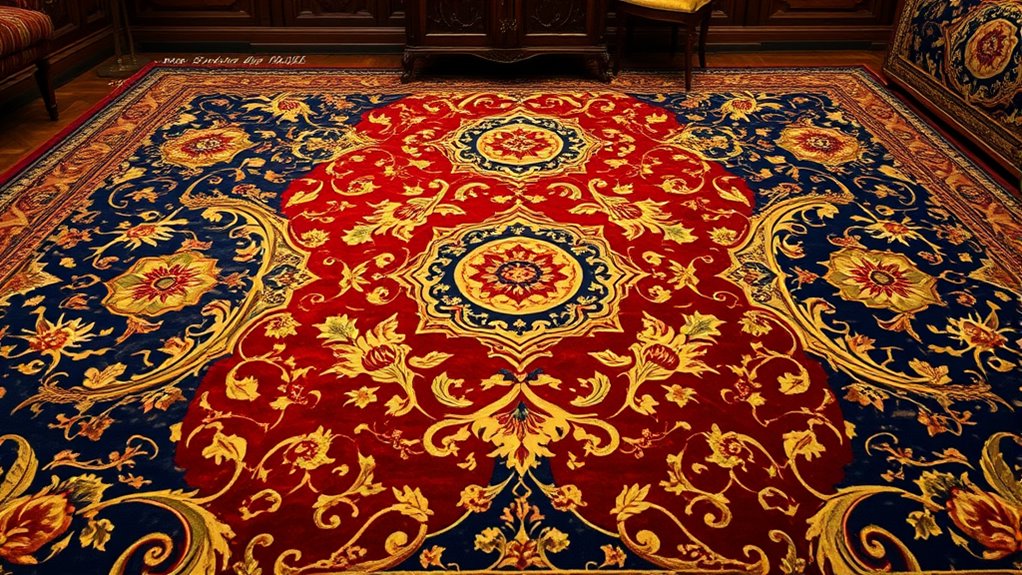
Over centuries, French Savonnerie carpets have evolved through a dynamic interplay of artistic innovation and cultural influences. Today, their styles reflect both tradition and modern trends. You’ll notice four key developments:
- Shifts toward more abstract and stylized motifs, aligning with contemporary design influence.
- Integration of bold color palettes to suit modern interior integration, emphasizing versatility.
- Simplification of patterns, balancing intricate detail with minimalist aesthetics.
- Fusion of classical elements with modern motifs to create timeless yet current pieces. These changes allow Savonnerie carpets to stay relevant, blending historical craftsmanship with contemporary tastes. As a collector, understanding this evolution helps you appreciate their adaptability and enduring appeal in diverse interior settings.
Notable Collections and Famous Examples
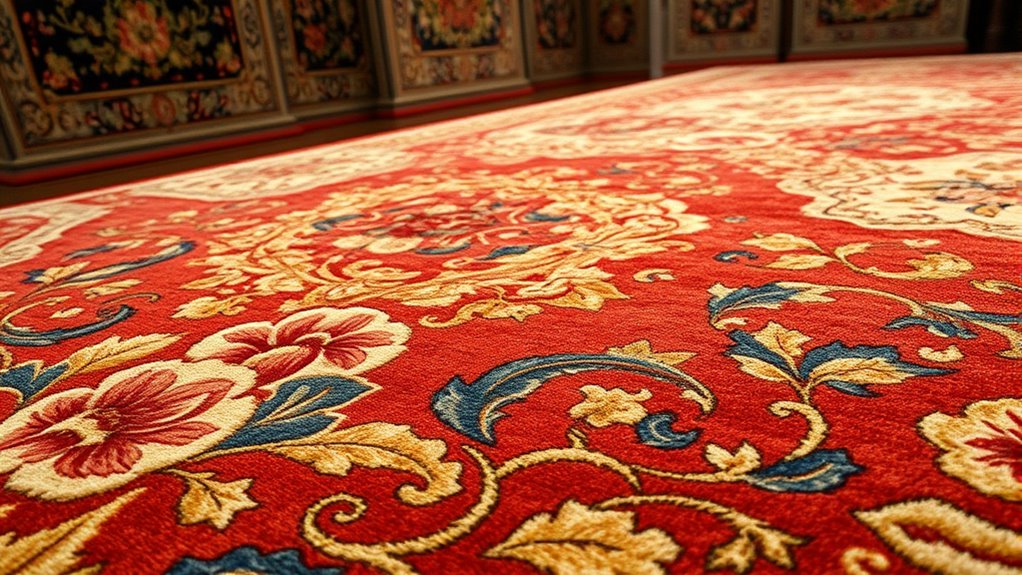
You’ll find that some French Savonnerie carpets are featured in renowned museums, showcasing their historical significance. Celebrity-owned pieces add a layer of prestige and intrigue to their story. Exploring these collections reveals just how cherished and influential these carpets have become over time.
Renowned Museum Pieces
French Savonnerie carpets have earned a distinguished place in museum collections worldwide, showcasing their exquisite craftsmanship and historical significance. These masterpieces often feature medieval motifs that reflect the rich cultural heritage of their era. When examining renowned museum pieces, you’ll notice:
- Exceptional textile preservation, allowing you to appreciate intricate details.
- Use of vibrant dyes that have endured centuries.
- Complex patterns blending floral, heraldic, and mythological elements.
- Unique craftsmanship that highlights the skill of original artisans.
These carpets serve as crucial links to history, offering insights into medieval art and textile techniques. Their preservation in museums ensures that future generations can study and admire their artistic and cultural importance, making them invaluable collector’s treasures.
Celebrity-Owned Carpets
Have you ever wondered which famous collectors and celebrities own stunning Savonnerie carpets? Celebrity influence has brought these masterpieces into the spotlight, making them prized possessions among the wealthy and famous. Notable collections include those owned by aristocrats, royals, and modern icons who appreciate their intricate craftsmanship. Some celebrities have even commissioned modern reinterpretations of traditional designs, blending history with contemporary style. These carpets often appear in high-profile homes, adding a touch of elegance and history to modern interiors. Their presence underscores the enduring appeal of French Savonnerie carpets and highlights how celebrity ownership elevates their status from antique treasures to symbols of luxury. If you’re passionate about collecting, understanding these notable examples can inspire your own appreciation of their timeless beauty and cultural significance.
Factors Influencing Value and Pricing
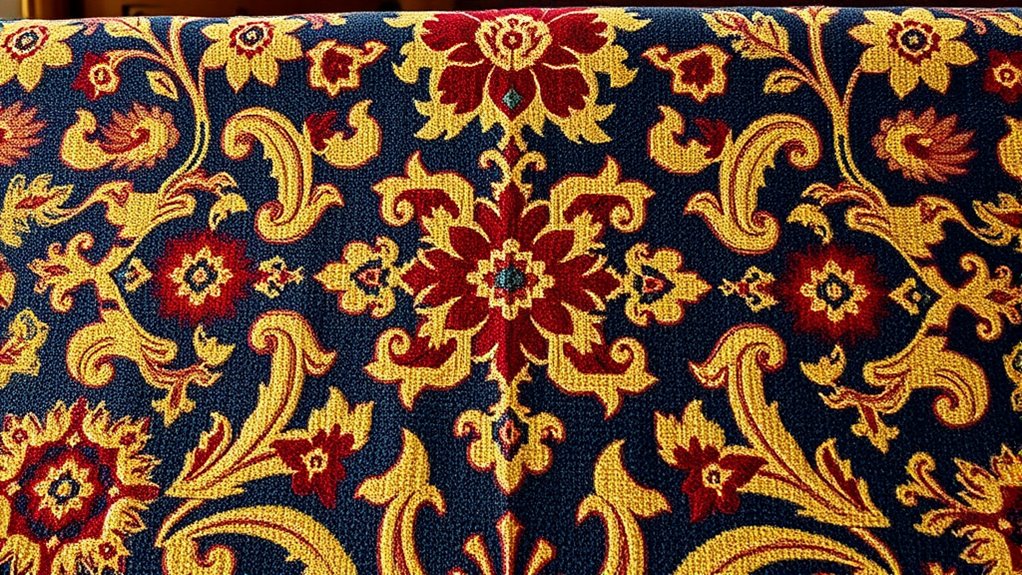
Several key factors determine the value and pricing of Savonnerie carpets, reflecting their craftsmanship, rarity, and condition. First, market demand plays a significant role; higher interest drives up prices. Second, provenance verification adds credibility, confirming authenticity and boosting value. Third, the carpet’s age and historical significance influence its worth, with older, well-preserved pieces commanding higher prices. Fourth, condition matters—carpets with minimal wear, no repairs, and vibrant colors fetch premium prices. Additionally, rarity affects desirability; limited editions or unique designs are more valuable. Overall, understanding these factors helps you appraise a Savonnerie carpet’s true worth and ensures you make informed purchasing decisions in the collector’s market.
Tips for Collecting and Caring for Savonnerie Carpets
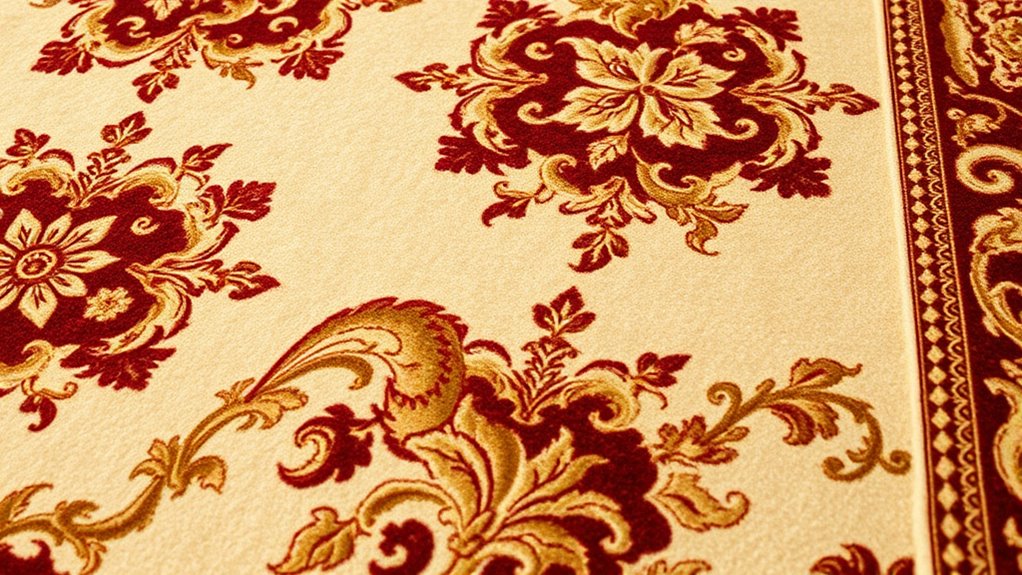
When collecting Savonnerie carpets, it’s important to prioritize proper care to preserve their beauty and value. Regular maintenance is key, especially if you want your carpet to fit seamlessly into a modern interior. Use gentle vacuuming without the beater bar to avoid damage, and rotate the carpet periodically to prevent uneven wear. Keep it away from direct sunlight to prevent fading. For stains, act quickly with a mild, pH-neutral cleaner. Here’s a quick guide:
| Cleaning Tip | Frequency | Caution |
|---|---|---|
| Gentle vacuuming | Weekly | Avoid harsh brushes |
| Spot cleaning | Immediately after stain | Test on small area first |
| Professional cleaning | Every 2-3 years | Use experts familiar with Savonnerie carpets |
This ensures your piece stays stunning for generations.
The Future of French Savonnerie Carpets in the Art World
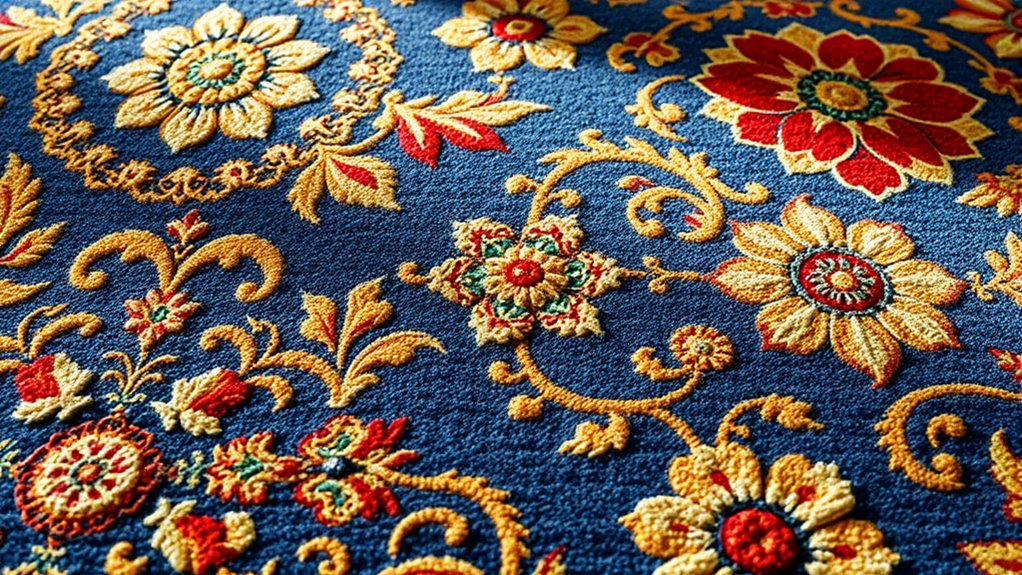
As contemporary artists and collectors increasingly seek to blend tradition with innovation, French Savonnerie carpets are poised to reclaim their place in the art world. The future involves embracing futuristic design elements and digital preservation techniques that enhance their relevance. You can expect:
- Integration of modern, abstract motifs alongside classic patterns to appeal to contemporary tastes.
- Use of digital preservation methods to document and restore carpets, guaranteeing their longevity.
- Collaboration with digital artists to create hybrid works that fuse textile craftsmanship with new media.
- Increased visibility through virtual galleries, making these carpets accessible to a global audience.
This evolution ensures Savonnerie carpets remain essential, relevant, and appreciated both as historic artifacts and modern artistic expressions.
Frequently Asked Questions
How Do I Authenticate a Vintage Savonnerie Carpet?
To authenticate a vintage Savonnerie carpet, start by examining its weave pattern, ensuring it matches traditional designs. Conduct a dye analysis to verify the colors are consistent with historical methods used in French craftsmanship. Look for signs of age, such as wear and patina, but be cautious of modern reproductions. Trust your instincts and seek expert appraisal if you’re unsure, so you can confidently identify an authentic piece.
What Are the Common Restoration Challenges for Savonnerie Rugs?
Restoring a Savonnerie rug is like untangling a complex web. You often face fringe deterioration, which weakens the rug’s edges, and dye bleeding, which threatens its vibrant patterns. These challenges require delicate handling and expert intervention to preserve the intricate designs. You must carefully stabilize the fringe and use specialized cleaning to prevent further dye loss, ensuring your treasured piece remains a stunning historical artifact for generations to come.
How Do Savonnerie Carpets Compare to Other European Antique Rugs?
You’ll find that Savonnerie carpets showcase exceptional European rug craftsmanship, often featuring intricate designs and luxurious materials. Compared to other antique European rugs, they tend to be more ornate and historically significant, which can enhance their antique rug valuation. While some styles may be more delicate or harder to restore, their rich history and craftsmanship make them highly sought after by collectors seeking unique, high-quality pieces.
Which Periods Are Most Sought After by Collectors?
Think of the most sought-after periods as rare gems in a treasure chest. You’ll find that the 17th and 18th centuries hold the greatest period significance, reflecting masterful craftsmanship and regal patronage. Collector preferences favor these eras because of their historical richness and artistry. By focusing on these periods, you align with what true connoisseurs prize, making your collection both valuable and a demonstration of timeless elegance.
Are There Modern Reproductions of French Savonnerie Carpets?
You’ll find that modern reproductions of French Savonnerie carpets do exist, crafted by skilled artisans who use traditional techniques to replicate the intricate designs. These reproductions aim to preserve the beauty and craftsmanship of the originals while offering a more affordable option. If you’re interested in collecting or decorating, look for pieces made with authentic artisan techniques, ensuring you get a reproduction that truly captures the essence of this historic art form.
Conclusion
By understanding the rich history and intricate craftsmanship of French Savonnerie carpets, you hold the key to appreciating their timeless beauty. These rugs are more than just floor coverings; they’re woven stories that continue to captivate collectors worldwide. As you explore and care for these masterpieces, you’ll discover they’re like a fine wine—getting better with age, adding a touch of elegance to your collection that’s truly worth its weight in history.

